HND Business: Analyzing Teamwork and Organizational Behavior Theories
VerifiedAdded on 2023/04/24
|7
|1988
|378
Essay
AI Summary
This essay discusses the benefits of teamwork, using real-life examples and focusing on Tuckman's theory of team development and Belbin's nine team roles. It reflects on a team project involving building a traditional bridge, identifying the team's stage as 'norming' according to Tuckman's model. The essay also analyzes the team's dynamics through the lens of Belbin's theory, highlighting the strengths and weaknesses observed within the team led by George. It emphasizes the importance of communication, positive attitudes, and conflict resolution skills in effective teamwork, linking these aspects to organizational behavior and workplace success. The conclusion underscores that teamwork, built on trust and mutual respect, leads to enhanced employee morale and the successful achievement of organizational goals.
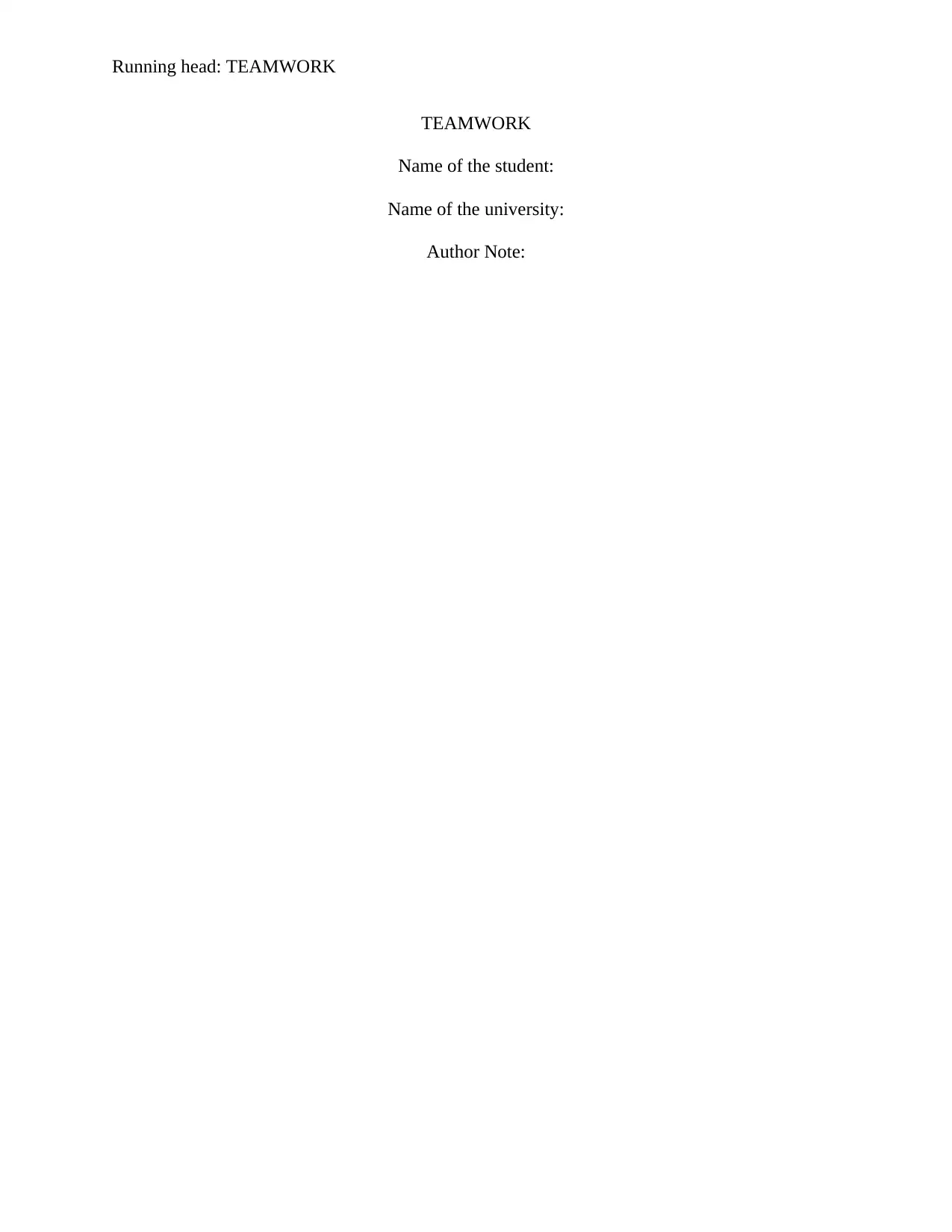
Running head: TEAMWORK
TEAMWORK
Name of the student:
Name of the university:
Author Note:
TEAMWORK
Name of the student:
Name of the university:
Author Note:
Paraphrase This Document
Need a fresh take? Get an instant paraphrase of this document with our AI Paraphraser
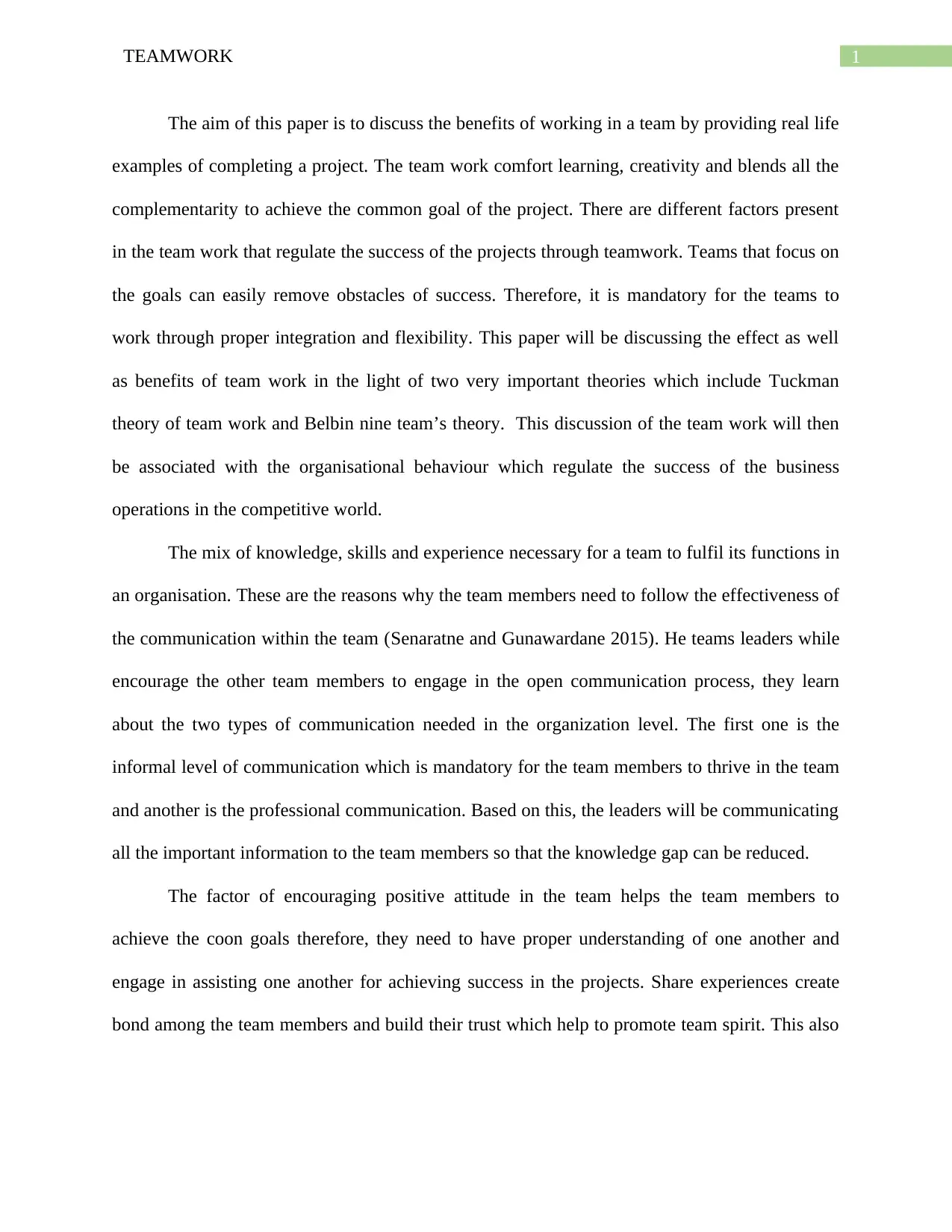
1TEAMWORK
The aim of this paper is to discuss the benefits of working in a team by providing real life
examples of completing a project. The team work comfort learning, creativity and blends all the
complementarity to achieve the common goal of the project. There are different factors present
in the team work that regulate the success of the projects through teamwork. Teams that focus on
the goals can easily remove obstacles of success. Therefore, it is mandatory for the teams to
work through proper integration and flexibility. This paper will be discussing the effect as well
as benefits of team work in the light of two very important theories which include Tuckman
theory of team work and Belbin nine team’s theory. This discussion of the team work will then
be associated with the organisational behaviour which regulate the success of the business
operations in the competitive world.
The mix of knowledge, skills and experience necessary for a team to fulfil its functions in
an organisation. These are the reasons why the team members need to follow the effectiveness of
the communication within the team (Senaratne and Gunawardane 2015). He teams leaders while
encourage the other team members to engage in the open communication process, they learn
about the two types of communication needed in the organization level. The first one is the
informal level of communication which is mandatory for the team members to thrive in the team
and another is the professional communication. Based on this, the leaders will be communicating
all the important information to the team members so that the knowledge gap can be reduced.
The factor of encouraging positive attitude in the team helps the team members to
achieve the coon goals therefore, they need to have proper understanding of one another and
engage in assisting one another for achieving success in the projects. Share experiences create
bond among the team members and build their trust which help to promote team spirit. This also
The aim of this paper is to discuss the benefits of working in a team by providing real life
examples of completing a project. The team work comfort learning, creativity and blends all the
complementarity to achieve the common goal of the project. There are different factors present
in the team work that regulate the success of the projects through teamwork. Teams that focus on
the goals can easily remove obstacles of success. Therefore, it is mandatory for the teams to
work through proper integration and flexibility. This paper will be discussing the effect as well
as benefits of team work in the light of two very important theories which include Tuckman
theory of team work and Belbin nine team’s theory. This discussion of the team work will then
be associated with the organisational behaviour which regulate the success of the business
operations in the competitive world.
The mix of knowledge, skills and experience necessary for a team to fulfil its functions in
an organisation. These are the reasons why the team members need to follow the effectiveness of
the communication within the team (Senaratne and Gunawardane 2015). He teams leaders while
encourage the other team members to engage in the open communication process, they learn
about the two types of communication needed in the organization level. The first one is the
informal level of communication which is mandatory for the team members to thrive in the team
and another is the professional communication. Based on this, the leaders will be communicating
all the important information to the team members so that the knowledge gap can be reduced.
The factor of encouraging positive attitude in the team helps the team members to
achieve the coon goals therefore, they need to have proper understanding of one another and
engage in assisting one another for achieving success in the projects. Share experiences create
bond among the team members and build their trust which help to promote team spirit. This also
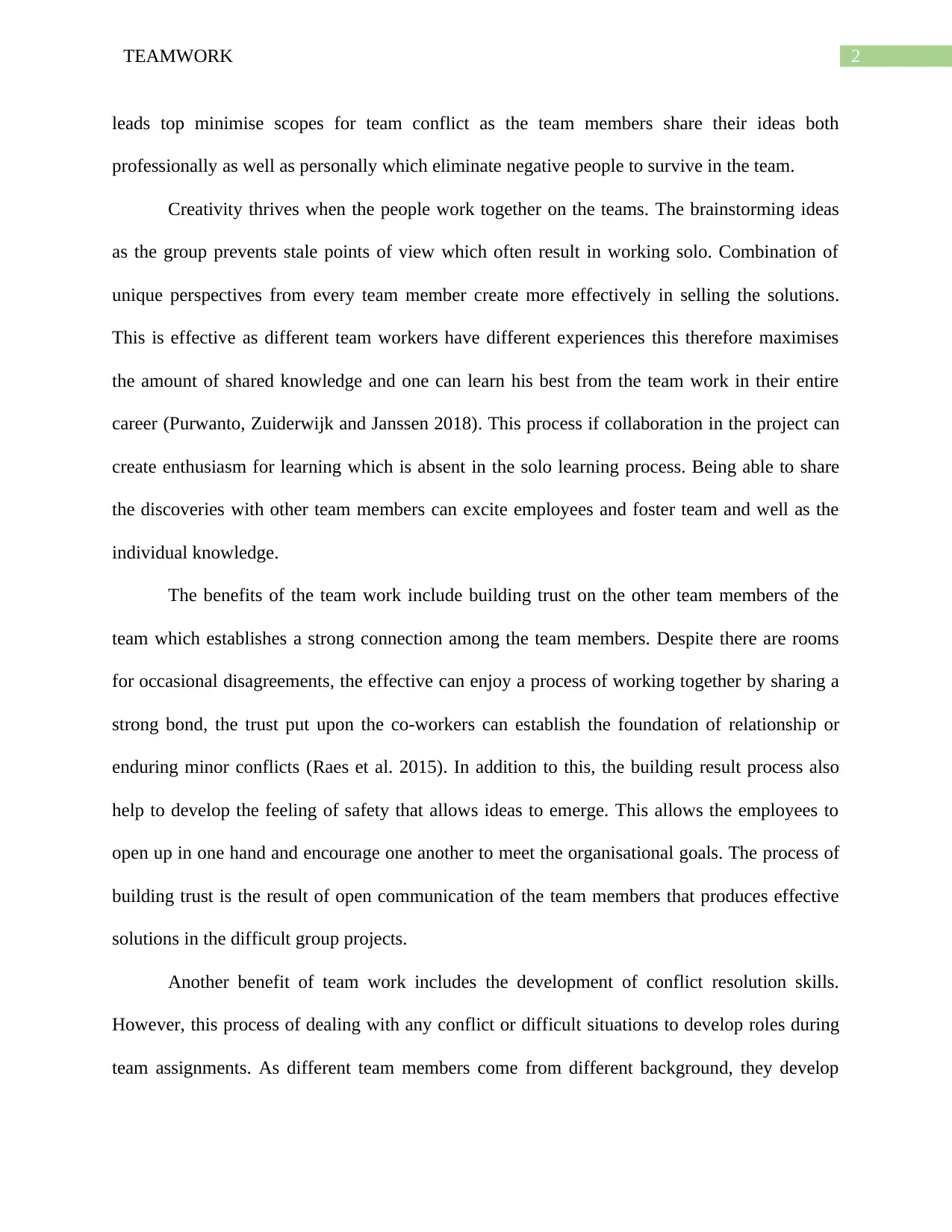
2TEAMWORK
leads top minimise scopes for team conflict as the team members share their ideas both
professionally as well as personally which eliminate negative people to survive in the team.
Creativity thrives when the people work together on the teams. The brainstorming ideas
as the group prevents stale points of view which often result in working solo. Combination of
unique perspectives from every team member create more effectively in selling the solutions.
This is effective as different team workers have different experiences this therefore maximises
the amount of shared knowledge and one can learn his best from the team work in their entire
career (Purwanto, Zuiderwijk and Janssen 2018). This process if collaboration in the project can
create enthusiasm for learning which is absent in the solo learning process. Being able to share
the discoveries with other team members can excite employees and foster team and well as the
individual knowledge.
The benefits of the team work include building trust on the other team members of the
team which establishes a strong connection among the team members. Despite there are rooms
for occasional disagreements, the effective can enjoy a process of working together by sharing a
strong bond, the trust put upon the co-workers can establish the foundation of relationship or
enduring minor conflicts (Raes et al. 2015). In addition to this, the building result process also
help to develop the feeling of safety that allows ideas to emerge. This allows the employees to
open up in one hand and encourage one another to meet the organisational goals. The process of
building trust is the result of open communication of the team members that produces effective
solutions in the difficult group projects.
Another benefit of team work includes the development of conflict resolution skills.
However, this process of dealing with any conflict or difficult situations to develop roles during
team assignments. As different team members come from different background, they develop
leads top minimise scopes for team conflict as the team members share their ideas both
professionally as well as personally which eliminate negative people to survive in the team.
Creativity thrives when the people work together on the teams. The brainstorming ideas
as the group prevents stale points of view which often result in working solo. Combination of
unique perspectives from every team member create more effectively in selling the solutions.
This is effective as different team workers have different experiences this therefore maximises
the amount of shared knowledge and one can learn his best from the team work in their entire
career (Purwanto, Zuiderwijk and Janssen 2018). This process if collaboration in the project can
create enthusiasm for learning which is absent in the solo learning process. Being able to share
the discoveries with other team members can excite employees and foster team and well as the
individual knowledge.
The benefits of the team work include building trust on the other team members of the
team which establishes a strong connection among the team members. Despite there are rooms
for occasional disagreements, the effective can enjoy a process of working together by sharing a
strong bond, the trust put upon the co-workers can establish the foundation of relationship or
enduring minor conflicts (Raes et al. 2015). In addition to this, the building result process also
help to develop the feeling of safety that allows ideas to emerge. This allows the employees to
open up in one hand and encourage one another to meet the organisational goals. The process of
building trust is the result of open communication of the team members that produces effective
solutions in the difficult group projects.
Another benefit of team work includes the development of conflict resolution skills.
However, this process of dealing with any conflict or difficult situations to develop roles during
team assignments. As different team members come from different background, they develop
⊘ This is a preview!⊘
Do you want full access?
Subscribe today to unlock all pages.

Trusted by 1+ million students worldwide
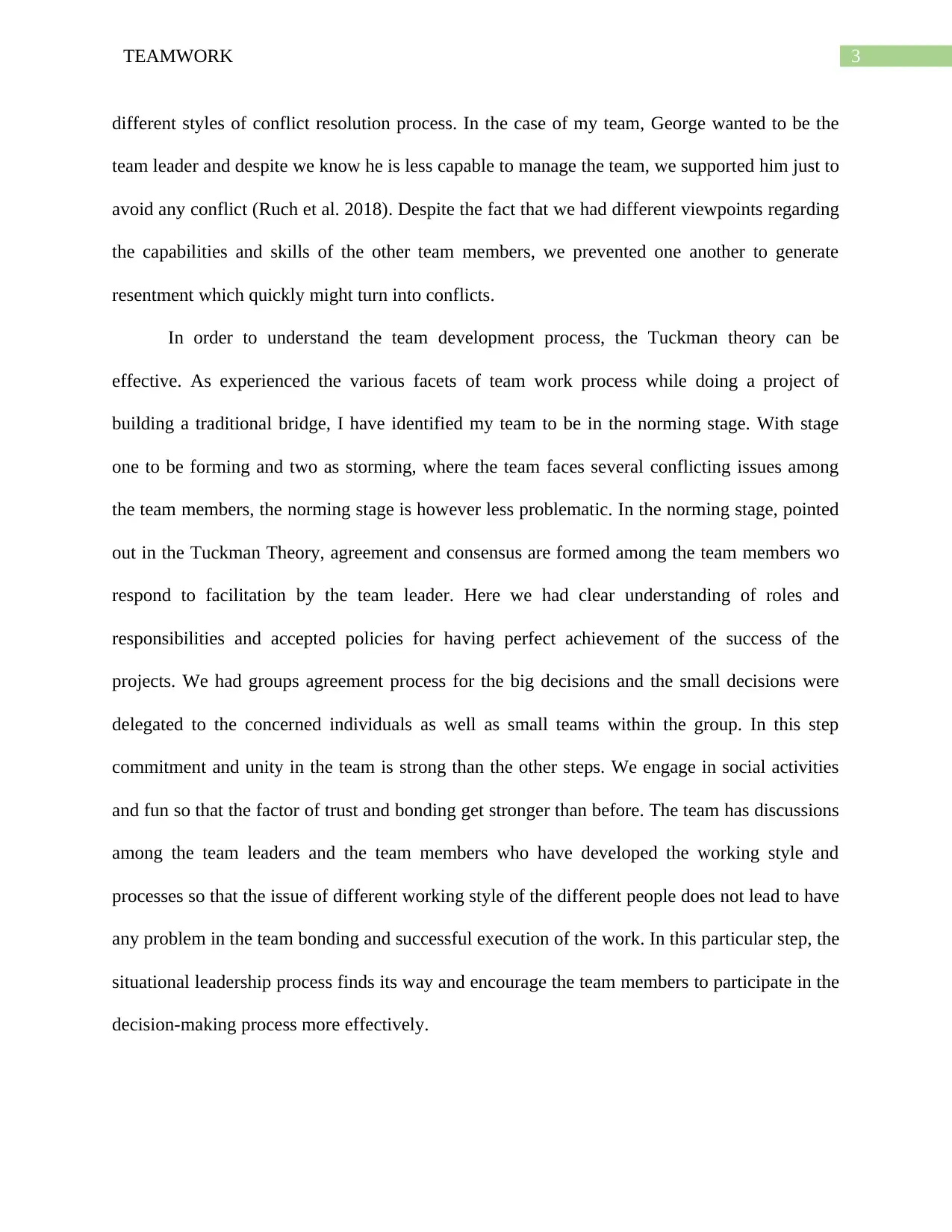
3TEAMWORK
different styles of conflict resolution process. In the case of my team, George wanted to be the
team leader and despite we know he is less capable to manage the team, we supported him just to
avoid any conflict (Ruch et al. 2018). Despite the fact that we had different viewpoints regarding
the capabilities and skills of the other team members, we prevented one another to generate
resentment which quickly might turn into conflicts.
In order to understand the team development process, the Tuckman theory can be
effective. As experienced the various facets of team work process while doing a project of
building a traditional bridge, I have identified my team to be in the norming stage. With stage
one to be forming and two as storming, where the team faces several conflicting issues among
the team members, the norming stage is however less problematic. In the norming stage, pointed
out in the Tuckman Theory, agreement and consensus are formed among the team members wo
respond to facilitation by the team leader. Here we had clear understanding of roles and
responsibilities and accepted policies for having perfect achievement of the success of the
projects. We had groups agreement process for the big decisions and the small decisions were
delegated to the concerned individuals as well as small teams within the group. In this step
commitment and unity in the team is strong than the other steps. We engage in social activities
and fun so that the factor of trust and bonding get stronger than before. The team has discussions
among the team leaders and the team members who have developed the working style and
processes so that the issue of different working style of the different people does not lead to have
any problem in the team bonding and successful execution of the work. In this particular step, the
situational leadership process finds its way and encourage the team members to participate in the
decision-making process more effectively.
different styles of conflict resolution process. In the case of my team, George wanted to be the
team leader and despite we know he is less capable to manage the team, we supported him just to
avoid any conflict (Ruch et al. 2018). Despite the fact that we had different viewpoints regarding
the capabilities and skills of the other team members, we prevented one another to generate
resentment which quickly might turn into conflicts.
In order to understand the team development process, the Tuckman theory can be
effective. As experienced the various facets of team work process while doing a project of
building a traditional bridge, I have identified my team to be in the norming stage. With stage
one to be forming and two as storming, where the team faces several conflicting issues among
the team members, the norming stage is however less problematic. In the norming stage, pointed
out in the Tuckman Theory, agreement and consensus are formed among the team members wo
respond to facilitation by the team leader. Here we had clear understanding of roles and
responsibilities and accepted policies for having perfect achievement of the success of the
projects. We had groups agreement process for the big decisions and the small decisions were
delegated to the concerned individuals as well as small teams within the group. In this step
commitment and unity in the team is strong than the other steps. We engage in social activities
and fun so that the factor of trust and bonding get stronger than before. The team has discussions
among the team leaders and the team members who have developed the working style and
processes so that the issue of different working style of the different people does not lead to have
any problem in the team bonding and successful execution of the work. In this particular step, the
situational leadership process finds its way and encourage the team members to participate in the
decision-making process more effectively.
Paraphrase This Document
Need a fresh take? Get an instant paraphrase of this document with our AI Paraphraser
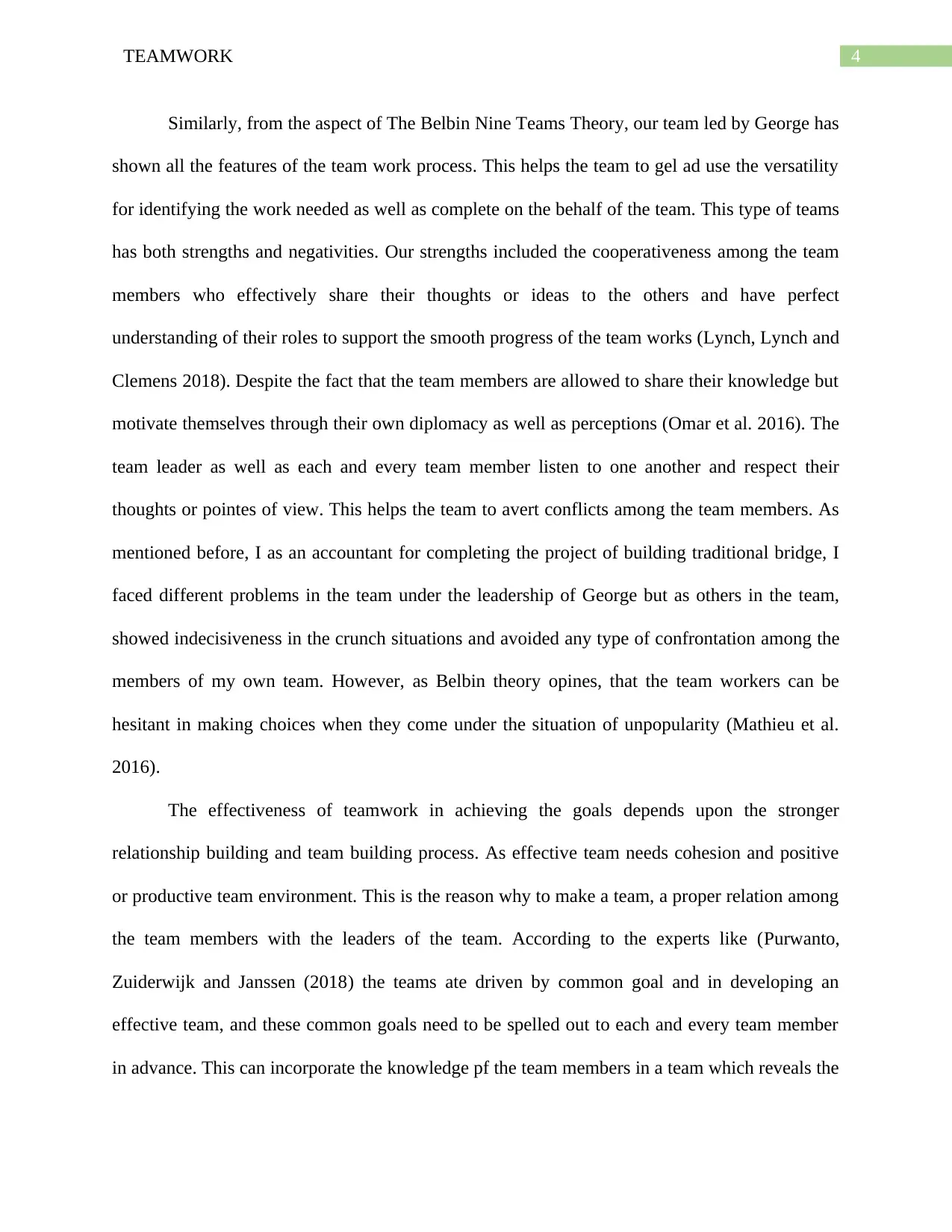
4TEAMWORK
Similarly, from the aspect of The Belbin Nine Teams Theory, our team led by George has
shown all the features of the team work process. This helps the team to gel ad use the versatility
for identifying the work needed as well as complete on the behalf of the team. This type of teams
has both strengths and negativities. Our strengths included the cooperativeness among the team
members who effectively share their thoughts or ideas to the others and have perfect
understanding of their roles to support the smooth progress of the team works (Lynch, Lynch and
Clemens 2018). Despite the fact that the team members are allowed to share their knowledge but
motivate themselves through their own diplomacy as well as perceptions (Omar et al. 2016). The
team leader as well as each and every team member listen to one another and respect their
thoughts or pointes of view. This helps the team to avert conflicts among the team members. As
mentioned before, I as an accountant for completing the project of building traditional bridge, I
faced different problems in the team under the leadership of George but as others in the team,
showed indecisiveness in the crunch situations and avoided any type of confrontation among the
members of my own team. However, as Belbin theory opines, that the team workers can be
hesitant in making choices when they come under the situation of unpopularity (Mathieu et al.
2016).
The effectiveness of teamwork in achieving the goals depends upon the stronger
relationship building and team building process. As effective team needs cohesion and positive
or productive team environment. This is the reason why to make a team, a proper relation among
the team members with the leaders of the team. According to the experts like (Purwanto,
Zuiderwijk and Janssen (2018) the teams ate driven by common goal and in developing an
effective team, and these common goals need to be spelled out to each and every team member
in advance. This can incorporate the knowledge pf the team members in a team which reveals the
Similarly, from the aspect of The Belbin Nine Teams Theory, our team led by George has
shown all the features of the team work process. This helps the team to gel ad use the versatility
for identifying the work needed as well as complete on the behalf of the team. This type of teams
has both strengths and negativities. Our strengths included the cooperativeness among the team
members who effectively share their thoughts or ideas to the others and have perfect
understanding of their roles to support the smooth progress of the team works (Lynch, Lynch and
Clemens 2018). Despite the fact that the team members are allowed to share their knowledge but
motivate themselves through their own diplomacy as well as perceptions (Omar et al. 2016). The
team leader as well as each and every team member listen to one another and respect their
thoughts or pointes of view. This helps the team to avert conflicts among the team members. As
mentioned before, I as an accountant for completing the project of building traditional bridge, I
faced different problems in the team under the leadership of George but as others in the team,
showed indecisiveness in the crunch situations and avoided any type of confrontation among the
members of my own team. However, as Belbin theory opines, that the team workers can be
hesitant in making choices when they come under the situation of unpopularity (Mathieu et al.
2016).
The effectiveness of teamwork in achieving the goals depends upon the stronger
relationship building and team building process. As effective team needs cohesion and positive
or productive team environment. This is the reason why to make a team, a proper relation among
the team members with the leaders of the team. According to the experts like (Purwanto,
Zuiderwijk and Janssen (2018) the teams ate driven by common goal and in developing an
effective team, and these common goals need to be spelled out to each and every team member
in advance. This can incorporate the knowledge pf the team members in a team which reveals the
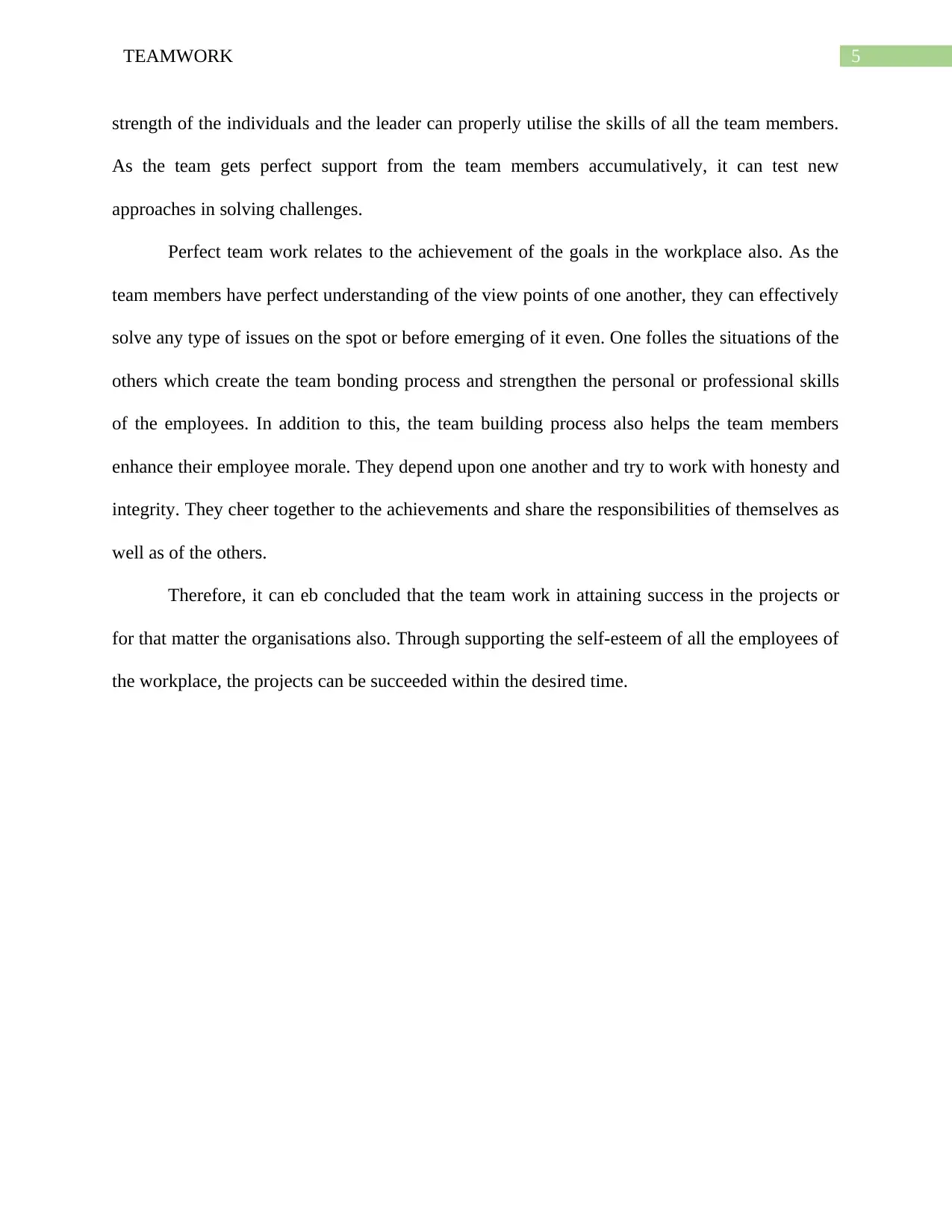
5TEAMWORK
strength of the individuals and the leader can properly utilise the skills of all the team members.
As the team gets perfect support from the team members accumulatively, it can test new
approaches in solving challenges.
Perfect team work relates to the achievement of the goals in the workplace also. As the
team members have perfect understanding of the view points of one another, they can effectively
solve any type of issues on the spot or before emerging of it even. One folles the situations of the
others which create the team bonding process and strengthen the personal or professional skills
of the employees. In addition to this, the team building process also helps the team members
enhance their employee morale. They depend upon one another and try to work with honesty and
integrity. They cheer together to the achievements and share the responsibilities of themselves as
well as of the others.
Therefore, it can eb concluded that the team work in attaining success in the projects or
for that matter the organisations also. Through supporting the self-esteem of all the employees of
the workplace, the projects can be succeeded within the desired time.
strength of the individuals and the leader can properly utilise the skills of all the team members.
As the team gets perfect support from the team members accumulatively, it can test new
approaches in solving challenges.
Perfect team work relates to the achievement of the goals in the workplace also. As the
team members have perfect understanding of the view points of one another, they can effectively
solve any type of issues on the spot or before emerging of it even. One folles the situations of the
others which create the team bonding process and strengthen the personal or professional skills
of the employees. In addition to this, the team building process also helps the team members
enhance their employee morale. They depend upon one another and try to work with honesty and
integrity. They cheer together to the achievements and share the responsibilities of themselves as
well as of the others.
Therefore, it can eb concluded that the team work in attaining success in the projects or
for that matter the organisations also. Through supporting the self-esteem of all the employees of
the workplace, the projects can be succeeded within the desired time.
⊘ This is a preview!⊘
Do you want full access?
Subscribe today to unlock all pages.

Trusted by 1+ million students worldwide
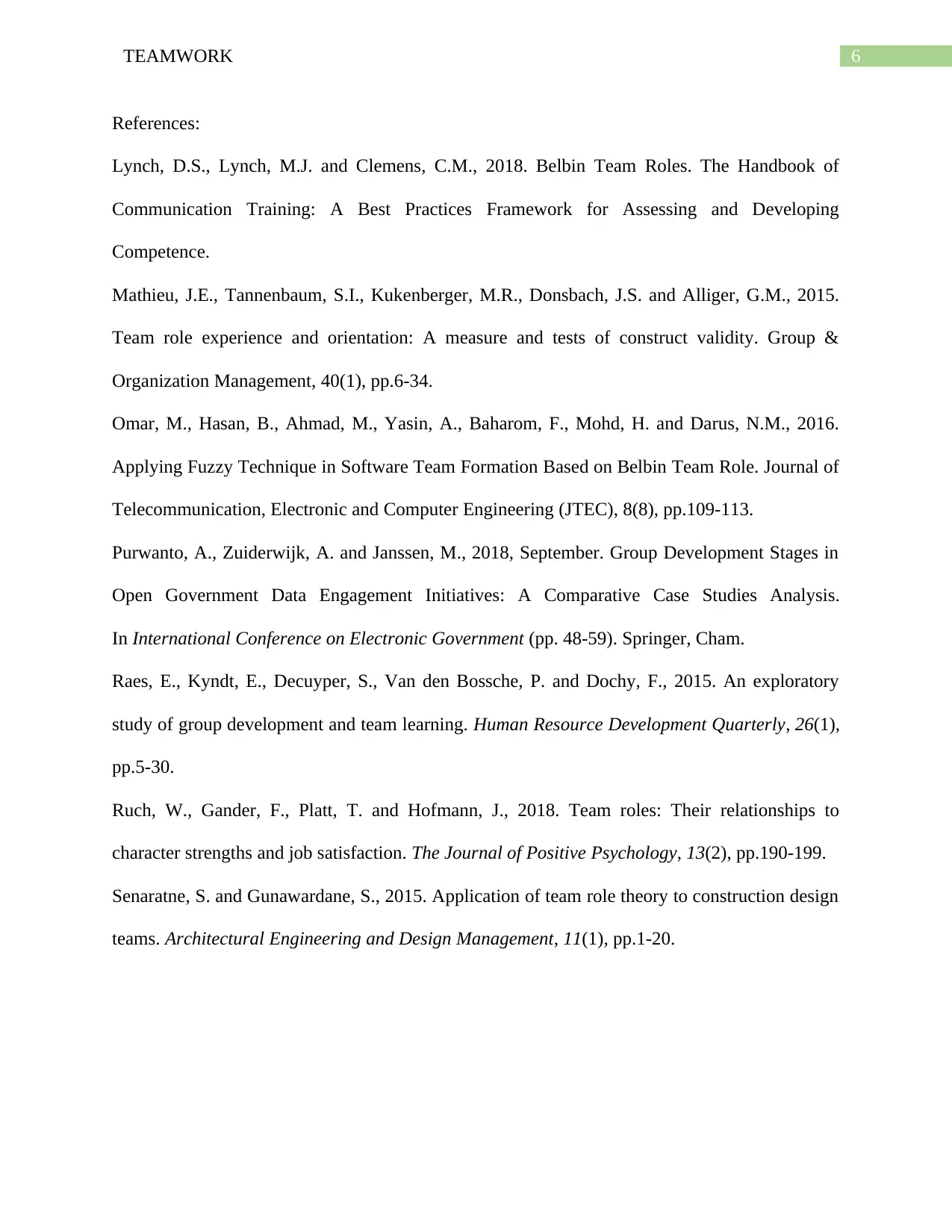
6TEAMWORK
References:
Lynch, D.S., Lynch, M.J. and Clemens, C.M., 2018. Belbin Team Roles. The Handbook of
Communication Training: A Best Practices Framework for Assessing and Developing
Competence.
Mathieu, J.E., Tannenbaum, S.I., Kukenberger, M.R., Donsbach, J.S. and Alliger, G.M., 2015.
Team role experience and orientation: A measure and tests of construct validity. Group &
Organization Management, 40(1), pp.6-34.
Omar, M., Hasan, B., Ahmad, M., Yasin, A., Baharom, F., Mohd, H. and Darus, N.M., 2016.
Applying Fuzzy Technique in Software Team Formation Based on Belbin Team Role. Journal of
Telecommunication, Electronic and Computer Engineering (JTEC), 8(8), pp.109-113.
Purwanto, A., Zuiderwijk, A. and Janssen, M., 2018, September. Group Development Stages in
Open Government Data Engagement Initiatives: A Comparative Case Studies Analysis.
In International Conference on Electronic Government (pp. 48-59). Springer, Cham.
Raes, E., Kyndt, E., Decuyper, S., Van den Bossche, P. and Dochy, F., 2015. An exploratory
study of group development and team learning. Human Resource Development Quarterly, 26(1),
pp.5-30.
Ruch, W., Gander, F., Platt, T. and Hofmann, J., 2018. Team roles: Their relationships to
character strengths and job satisfaction. The Journal of Positive Psychology, 13(2), pp.190-199.
Senaratne, S. and Gunawardane, S., 2015. Application of team role theory to construction design
teams. Architectural Engineering and Design Management, 11(1), pp.1-20.
References:
Lynch, D.S., Lynch, M.J. and Clemens, C.M., 2018. Belbin Team Roles. The Handbook of
Communication Training: A Best Practices Framework for Assessing and Developing
Competence.
Mathieu, J.E., Tannenbaum, S.I., Kukenberger, M.R., Donsbach, J.S. and Alliger, G.M., 2015.
Team role experience and orientation: A measure and tests of construct validity. Group &
Organization Management, 40(1), pp.6-34.
Omar, M., Hasan, B., Ahmad, M., Yasin, A., Baharom, F., Mohd, H. and Darus, N.M., 2016.
Applying Fuzzy Technique in Software Team Formation Based on Belbin Team Role. Journal of
Telecommunication, Electronic and Computer Engineering (JTEC), 8(8), pp.109-113.
Purwanto, A., Zuiderwijk, A. and Janssen, M., 2018, September. Group Development Stages in
Open Government Data Engagement Initiatives: A Comparative Case Studies Analysis.
In International Conference on Electronic Government (pp. 48-59). Springer, Cham.
Raes, E., Kyndt, E., Decuyper, S., Van den Bossche, P. and Dochy, F., 2015. An exploratory
study of group development and team learning. Human Resource Development Quarterly, 26(1),
pp.5-30.
Ruch, W., Gander, F., Platt, T. and Hofmann, J., 2018. Team roles: Their relationships to
character strengths and job satisfaction. The Journal of Positive Psychology, 13(2), pp.190-199.
Senaratne, S. and Gunawardane, S., 2015. Application of team role theory to construction design
teams. Architectural Engineering and Design Management, 11(1), pp.1-20.
1 out of 7
Related Documents
Your All-in-One AI-Powered Toolkit for Academic Success.
+13062052269
info@desklib.com
Available 24*7 on WhatsApp / Email
![[object Object]](/_next/static/media/star-bottom.7253800d.svg)
Unlock your academic potential
Copyright © 2020–2025 A2Z Services. All Rights Reserved. Developed and managed by ZUCOL.





